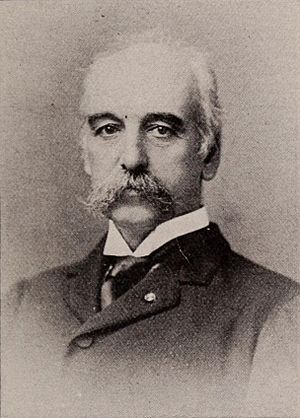Alfred Alexander Woodhull facts for kids
Quick facts for kids
Alfred Alexander Woodhull
|
|
|---|---|
 |
|
| Born | April 13, 1837 |
| Died | October 18, 1921 (aged 84) Princeton
|
| Nationality | United States |
| Citizenship | Army |
| Education | Lawrenceville School |
| Occupation | Surgeon |
| Known for | First to call to the attention of the service the necessity of co-operation between the medical and line officers in the promotion of military hygiene |
| Relatives | Dr. Alfred Alexander and Anna Maria (Salomons) Woodhull |
| Medical career | |
| Institutions | Medical Corps |
| Notable works | Provisional Manual for Exercise of Company Bearers and Hospital Corp |
| Awards | Gold medal of the Military Service Institution |
Alfred Alexander Woodhull (born April 13, 1837 – died October 18, 1921) was an American army doctor, also known as a surgeon. He was a very important person in military medicine. He won a gold medal in 1885 and another prize in 1907. Woodhull was the first to say that doctors and other army officers needed to work together. This cooperation was important for keeping soldiers healthy and clean.
Contents
Growing Up and Education
Alfred Alexander Woodhull was born in Princeton, New Jersey, on April 13, 1837. His parents were Dr. Alfred Alexander and Anna Maria Woodhull. A famous person in his family was John Witherspoon. John Witherspoon was one of the people who signed the United States Declaration of Independence.
Alfred went to the Lawrenceville School and finished in 1852. Then, he studied at the College of New Jersey. He earned his first degree in 1856. In 1859, he got his master's degree from the same college. He also earned his medical degree from the University of Pennsylvania that year. After finishing school, he worked as a doctor in Leavenworth, Kansas, and later in Eudora, Kansas.
Serving in the Army
When the American Civil War started, Alfred Woodhull helped gather a group of soldiers. He became a lieutenant. On September 19, 1861, he joined the Army Medical Corps. He served as a doctor throughout the entire war.
From 1864 to 1865, he was a medical inspector for the Army of the James. This meant he checked on the health and medical care of soldiers. In March 1865, he was given an honorary rank of lieutenant-colonel.
After the Civil War
After the war ended, Woodhull worked at the Army Medical Museum in Washington, D.C.. In 1866, he helped create the "Surgical Section" of a special book. This book was a Catalogue of the United States Army Medical Museum. In 1868, he wrote a report about the uniforms and clothes of soldiers. On December 15, 1868, he married Margaret Ellicott from Baltimore, Maryland.
He also worked in the office of the Surgeon-General. This is the top doctor for the U.S. Army. In 1875 and 1876, he wrote papers about using a plant called ipecacuanha. He suggested using small amounts of it to treat a sickness called dysentery.
Teaching and Leadership
From 1886 to 1890, Woodhull taught about military hygiene. He taught at the Infantry and Cavalry School at Fort Leavenworth, Kansas. This school trained army officers. From 1892 to 1895, he was in charge of the Army and Navy Hospital in Hot Springs, Arkansas.
In 1881, he wrote a report about his college class from 1856. He won a gold medal for his paper called "The Enlisted Soldier." This paper was published in a journal in March 1887.
In 1891, he traveled to England to learn about how the British Army took care of its soldiers. He wrote a report about what he learned in 1894. In 1895, he became a medical inspector in Colorado. In 1899, he became the chief surgeon for the Department of the Pacific in Manila. He wrote two important manuals: Provisional Manual for Exercise of Company Bearers and Hospital Corp in 1889, and Notes on Military Hygiene for Officers of the Line.
He retired from the army in 1901. In 1904, he was promoted to brigadier-general on the retired list. This was a high honor.
Life After the Army
After retiring from the U.S. Army, Alfred Woodhull went back to Princeton. From 1902 to 1907, he taught about personal hygiene and public health. In 1906, he wrote a book called Personal Hygiene: Designed for Undergraduates.
In 1907, he won the Seaman prize for an article he wrote. This article was about teaching hygiene and sanitation in military schools. It was published in a journal in 1908. In 1913, he wrote a study about the Battle of Princeton. Alfred Alexander Woodhull died in Princeton on October 18, 1921.

